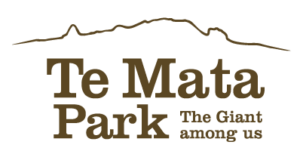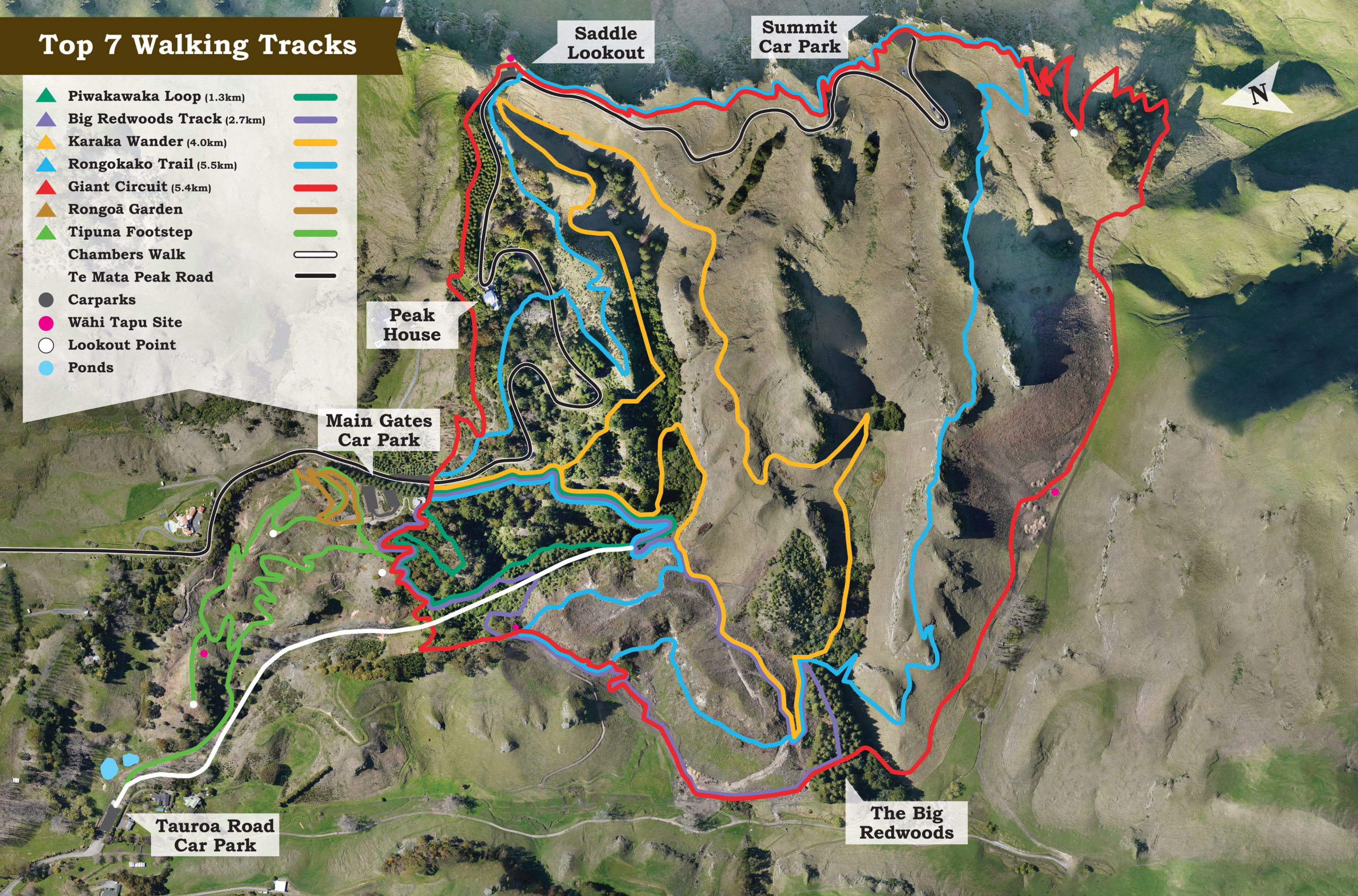
Intermediate: Walking for under 2 hours return, suitable for people of moderate fitness ability. Track is generally well formed with some rough, muddy, or uneven sections and simple switchbacks and inclines.
An outing to the stunning Te Hau Valley (Giant) Redwoods is the perfect spot for a picnic, or game of hide and seek. The loop track takes in a great lookout point over the Heretaunga Plains, the Giant Redwoods, and beautiful native bush.
Te Hau Valley Redwoods
 This grove of 223 stunning California redwoods (Sequoia sempervirens) was planted in 1927 and many are now over 40 metres tall. The Chambers family were great experimenters with tree planting and, having generally favoured eucalypts, decided to try a conifer species. Noting the similarities between the climates of Hawke’s Bay and coastal California, they decided to plant a large grove of redwoods.
This grove of 223 stunning California redwoods (Sequoia sempervirens) was planted in 1927 and many are now over 40 metres tall. The Chambers family were great experimenters with tree planting and, having generally favoured eucalypts, decided to try a conifer species. Noting the similarities between the climates of Hawke’s Bay and coastal California, they decided to plant a large grove of redwoods.
Native to America, the redwood is an evergreen and extremely long-lived tree with a life span of 2,500 to 3,500 years. They are the tallest trees now living on earth – the record-holder is the Hyperion tree in Northern California which measures 115.61metres (379.3 feet). Redwoods have a conical crown with horizontal branches. Their bark is very thick – up to 30cm – and quite soft and fibrous, with a bright red-brown colour when freshly cut which is where the name redwood comes from. The leaves tend to lie in a flat plane to maximise their ability to capture sunlight. The Giant Redwoods is one of the most popular places in Te Mata Park and has been the setting for weddings, concerts and even Shakespearean plays.
Little Limestone Cave
 Archaeologists are very interested in limestone caves like this one, as they were often used by moa for nesting and sleeping, and some still contain remains of moa droppings. Moa would have certainly roamed through the Park, and bones of the little bush moa were found by local children nearby 30 years ago.
Archaeologists are very interested in limestone caves like this one, as they were often used by moa for nesting and sleeping, and some still contain remains of moa droppings. Moa would have certainly roamed through the Park, and bones of the little bush moa were found by local children nearby 30 years ago.
These caves are common in limestone country, where softer areas are gradually worn away by weather to form the perfect spot for a moa to take a nap.
Lemon-Scented Eucalypt
 The upper section of Chambers Walk is planted with a grove of Eucalyptus Citriodora, or Lemon-Scented Eucalypts which grow to around 35 metres in height and are native to Australia. Also known as the Blue Spotted Gum, they have smooth, pale bark and a narrow-leaved crown which smells strongly of lemons, especially after rain.
The upper section of Chambers Walk is planted with a grove of Eucalyptus Citriodora, or Lemon-Scented Eucalypts which grow to around 35 metres in height and are native to Australia. Also known as the Blue Spotted Gum, they have smooth, pale bark and a narrow-leaved crown which smells strongly of lemons, especially after rain.
The Lemon-Scented Eucalypt is a favourite source of pollen for bees and is also used for structural timber in building. These trees were planted in Te Mata Park in the 1980s and are an important food source for birds and insects.
Chambers Walk
 Chambers Walk is named after the family who created Te Mata Park and gifted it in perpetuity to the community. The land that makes up Te Mata Park was included in a large block purchased in 1862 by early farmer settler John Chambers (pictured). In 1927, as a memorial to their father, his sons Bernard, John and Mason gifted a 99 hectare reserve on the upper Havelock North hills, including Te Mata Peak, to the people of Hawke’s Bay. So Te Mata Park was formed and is ours forever, with further protection granted in 1997 under the QEII National Trust for open space.
Chambers Walk is named after the family who created Te Mata Park and gifted it in perpetuity to the community. The land that makes up Te Mata Park was included in a large block purchased in 1862 by early farmer settler John Chambers (pictured). In 1927, as a memorial to their father, his sons Bernard, John and Mason gifted a 99 hectare reserve on the upper Havelock North hills, including Te Mata Peak, to the people of Hawke’s Bay. So Te Mata Park was formed and is ours forever, with further protection granted in 1997 under the QEII National Trust for open space.
The Park’s Trust Deed specifies that a male or female descendant of the original grantors must be a member of the Trust. For over 80 years, a long line of Chambers men have been committed to the ongoing care and protection of the Park, though there has yet to be a Chambers woman on the Board. Since 2000, Bruno Chambers, great great grandson of John Chambers, has served on the Trust Board as both Chairman and Trustee.
Kawakawa
 Kawakawa (Macropiper excelsum) is a small tree which is found throughout the North Island and upper South Island of New Zealand and is common in all the bush areas of Te Mata Park. Also known as the pepper tree, kawakawa leaves are often covered with insect holes which are mainly caused by the kawakawa looper moth caterpillar. Kawakawa was one of the most important healing herbs used by Māori and is still widely used today. A tea can be made from the leaves or roots and used for bladder and stomach and indigestion problems and to relieve pain. The leaves are used to heal cuts, bruises and nettle stings. Related to black pepper, Kawakawa seeds can also be used as a cooking spice.
Kawakawa (Macropiper excelsum) is a small tree which is found throughout the North Island and upper South Island of New Zealand and is common in all the bush areas of Te Mata Park. Also known as the pepper tree, kawakawa leaves are often covered with insect holes which are mainly caused by the kawakawa looper moth caterpillar. Kawakawa was one of the most important healing herbs used by Māori and is still widely used today. A tea can be made from the leaves or roots and used for bladder and stomach and indigestion problems and to relieve pain. The leaves are used to heal cuts, bruises and nettle stings. Related to black pepper, Kawakawa seeds can also be used as a cooking spice.
Ongaonga
 Ongaonga (Urtica ferox) is a nettle that is found only in New Zealand. Sometimes known as the tree nettle, Ongaonga has woody stems and unusually large stinging spines, and can grow to 5 metres tall, making it the world’s largest nettle.
Ongaonga (Urtica ferox) is a nettle that is found only in New Zealand. Sometimes known as the tree nettle, Ongaonga has woody stems and unusually large stinging spines, and can grow to 5 metres tall, making it the world’s largest nettle.
Even the lightest touch can result in a painful sting that lasts several days. The hollow needle-like spines, which are found on the leaves and stems of the plant are filled with a neurotoxin which causes a rash, irritation, pain and sometimes even damage to the nervous system. There has only been one recorded human death from contact—a lightly clad hunter who died five hours after walking through a dense patch.
Ongaonga has a huge role to play in the recovery of native butterflies as it is the preferred food plant for larvae of the New Zealand red admiral butterfly or kahukura. They also use it as a relatively safe home, rolling up the tree-nettle leaves into ‘tents’ where they are protected from potential predators.
 Five times winner of the prestigious international green space award.
Five times winner of the prestigious international green space award.

 EASY: Easy walking for less than an hour return, suitable for people of most ages and fitness levels. Track is well formed on a mostly even surface with no prolonged steep sections.
EASY: Easy walking for less than an hour return, suitable for people of most ages and fitness levels. Track is well formed on a mostly even surface with no prolonged steep sections. 












 Advanced: Walking for 1.5-3 hours return, suitable for people of moderate to high fitness ability. Track can be unformed, muddy, or uneven in some sections. Intense incline in some areas with high cliffs and extreme drop offs.
Advanced: Walking for 1.5-3 hours return, suitable for people of moderate to high fitness ability. Track can be unformed, muddy, or uneven in some sections. Intense incline in some areas with high cliffs and extreme drop offs. 





